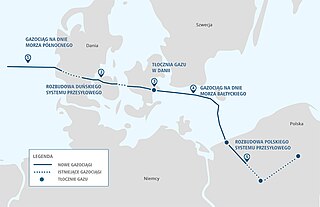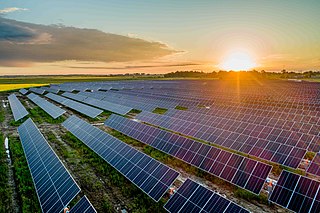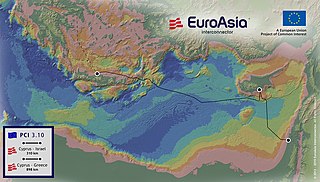Related Research Articles

Ormen Lange is a natural gas field on the Norwegian continental shelf. It is situated 120 kilometres (75 mi) northwest of Kristiansund, where seabed depths vary between 800 and 1,100 metres. The field is named after the famous longship Ormen Lange of Olaf Tryggvason, a 10th-century Viking king of Norway.
Ørsted A/S is a Danish multinational energy company. Headquartered in Fredericia, Denmark, Ørsted is the largest energy company in Denmark. The company adopted its current name on 6 November 2017. It was previously known as DONG.
Nord Stream is a pair of offshore natural gas pipelines in Europe that run under the Baltic Sea from Russia to Germany. It consists of the Nord Stream 1 (NS1) pipeline running from Vyborg in northwestern Russia, near Finland, and the Nord Stream 2 (NS2) pipeline running from Ust-Luga in northwestern Russia near Estonia. Both pipelines run to Lubmin in the northeastern German state of Mecklenburg-Vorpommern. Each pipeline contains two pipes, denoted A and B; each of the four pipes is approximately 1,200 kilometres (750 mi) long and with approximate diameters of 1,220 millimetres (48 in). The combined capacity of the four pipes is 110 billion cubic metres per annum of natural gas.
Tyra West – F3 pipeline is a 100-kilometre (62 mi) long natural gas submarine pipeline connecting Danish and Dutch continental shelf pipeline systems. It facilitates the export of Danish gas into North West Europe. The 660 millimetres (26 in) pipeline, which cost over US$200 million, runs from the Maersk-operated Tyra West platform on the Danish continental shelf to the F3 – FB platform on the Dutch continental shelf. From F3 – FB platform, gas is fed through the NOGAT pipeline system to the Netherlands natural gas hub in Den Helder.
Balticconnector is a bi-directional natural gas pipeline between Ingå, Finland and Paldiski, Estonia operated by Gasgrid Finland and Elering. It connects the Estonian and Finnish gas grids, and provides Finland with access to the Inčukalns underground gas storage facility in Latvia.

Europipe II is a natural gas pipeline from the Kårstø processing plant north of Stavanger to a receiving terminal at Dornum in Germany. It came on stream on 1 October 1999.
White Stream is a proposed pipeline project to transport natural gas from the Caspian region to Romania and Ukraine with further supplies to Central Europe.

South Stream is a canceled pipeline project to transport natural gas of the Russian Federation through the Black Sea to Bulgaria and through Serbia, Hungary and Slovenia further to Austria. It was never finished.

The Trans Adriatic Pipeline is a natural gas pipeline operational since 2020, running from Greece through Albania and the Adriatic Sea to Italy. It is the final section of the Southern Gas Corridor originating in Azerbaijan. As of 2022, capacity is 10 bcm per year.
Skanled was a planned natural gas offshore pipeline connecting Norway to Sweden and Denmark.

The Baltic Pipe is a natural gas pipeline between Europipe II and Poland. It is a strategic infrastructure project to create a new European gas supply corridor.

Tyra Field is the largest gas condensate field in the Danish Sector of the North Sea. It was discovered in 1968 and production started in 1984. The field is owned by Dansk Undergrunds Consortium, a partnership between Total, BlueNord and Nordsofonden, and operated by Total. The reservoir depth is about 2,000 metres (6,600 ft) and it covers area of 90 kilometres (56 mi) in the water depth of 37–40 metres (121–131 ft). The Tyra field has a number of satellite fields, including Roar, Svend and Tyra Southeast fields.

Denmark's western electrical grid is part of the Synchronous grid of Continental Europe whereas the eastern part is connected to the Synchronous grid of Northern Europe via Sweden.
Estonia's electricity sector is interconnected with regional energy markets, particularly through connections with Finland, Latvia, and Russia. The direct electrical interconnection with Finland was established in 2006 and was further strengthened by the Estlink 2 interconnector in 2014. Estonia joined the Nord Pool Spot market by 2012, securing its own price area within this regional electricity market.

Lithuania is a net energy importer. In 2019 Lithuania used around 11.4 TWh of electricity after producing just 3.6 TWh.
Latvia is a net energy importer. Primary energy use in Latvia was 49 TWh, or 22 TWh per million persons in 2009. In 2018, electricity consumption per capita was 3731 kWh.

The Great Sea Interconnector, formerly known as the EuroAsia Interconnector is a planned HVDC interconnector between the Greek, Cypriot, and Israeli power grids via the world's longest submarine power cable, with a length of 310 kilometres (190 mi) from Israel to Cyprus and 898 kilometres (558 mi) from Cyprus to Greece for a total of 1,208 kilometres (751 mi).
Gas Interconnector Greece–Bulgaria is a natural gas pipeline from the Greek to the Bulgarian natural gas pipeline network. It became operational on 1 October 2022.
The Galata gas field is a natural gas field located on the continental shelf of the Black Sea approximately 25km Southeast of Varna, Bulgaria. The field was the first to be developed offshore Bulgaria, and at peak production provided more than 16% of Bulgaria's domestic gas needs, the platform and associated infrastructure is still the only production facility located in the Bulgarian Black Sea.
References
- 1 2 "Baltic Gas Interconnector Info". Baltic Gas Interconnector. Archived from the original on 12 April 2005. Retrieved 1 December 2009.
- ↑ IEA (2004). Energy Policies of IEA Countries: Sweden 2004. OECD. p. 80. ISBN 978-92-64-10793-9.
- 1 2 IEA (2008). Energy Policies of IEA Countries: Sweden 2008 (PDF). OECD. p. 67. ISBN 978-92-64-04333-6. Archived from the original (PDF) on 1 October 2011. Retrieved 8 August 2011.
- ↑ "EU nod for Baltic gas pipe". Upstream Online . 19 March 2001. Retrieved 1 December 2009.
- ↑ Inquiry pursuant to Article 17 of Regulation (EC) No 1/2003 into the European gas and electricity sectors (Final Report) (PDF). Brussels: Commission of the European Communities. 10 January 2007. Archived from the original (PDF) on 25 October 2012. Retrieved 1 December 2009.